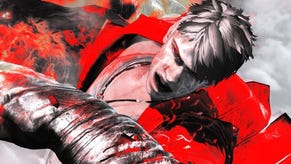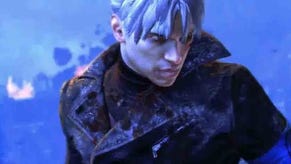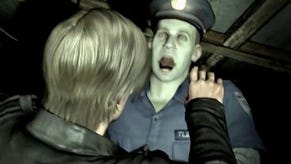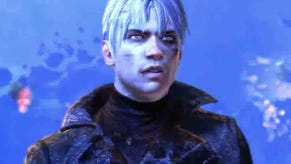DmC Devil May Cry review
Heaven and Hell.
There are extremes, and then there's DmC. This reinvention of Devil May Cry is capable of leaving you open-mouthed in amazement, gazing in wonder while clutching the joypad so hard it creaks - but it also easily segues into boredom and, occasionally, frustration. When DmC gets going it is sensational and when it slows down it's barely average. It's the 10/10 game that won't stop forgetting itself.
Dante's new look is a mix of hard-edged and drop-dead gorgeous, every stance filled with arrogance. Even more irresistible is the way he moves. A wiry powerhouse that runs on flair, every arc and sweep of this Dante's blade oozes over-confidence to the extent that it sometimes leaves him stumbling. But only for an instant. The animation throughout DmC is exquisite and Dante is the showcase, his hundreds of potential moves stitched together into the most incredible extended sequences. With attitude in spades and a clutch of killer lines, there have been few better reinventions of a classic character than this.
Then there's the combat system, the thing everyone was concerned about, which turns out to be DmC's trump card. With Ninja Theory on development duties you can take fluidity and style for granted, but the sheer range and utility of Dante's moveset is what's most impressive.
There's a big inheritance from Devil May Cry 4's Nero in the pair of chains that Dante can use either to zoom towards enemies or pull them in, giving you incredible flexibility of movement. These moves quickly become a near-automatic piloting system during combat, setting up enemies beautifully. You whip into huge rucks and arrive with an uppercut before eviscerating everything around with a whirling scythe that becomes more powerful with each hit - or you yank irritating cherubs out of the sky and pound them into paste before they fly off again.

The system is introduced gradually as Dante's armoury unlocks. You've acquired everything by about two-thirds of the way through the game, though it'll take several play-throughs to fully upgrade the lot. Weapons are split into Angel (blue) and Devil (red) types, toggled by holding the left or right trigger respectively.
The Angel weapons are a scythe and a pair of oversized shuriken, both of which specialise in dealing damage to groups of enemies. The former whirs around Dante's still centre like a rotor blade, while the latter shoot off at angles, simultaneously herding and shredding baddies. By contrast, the Devil weapons are about absolutely smashing things into bits: a massive axe that hits like a truck, destroying defences, and a giant pair of lava fists that can be charged to devastating effect. (In one of DmC's cutest nods, the latter's uppercut is a crucial tool for knocking big enemies out of charges - and, of course, it's a perfect dragon punch.)
Between these extremes sits Dante's classic sword Rebellion, a weapon of supreme utility that never stops revealing new tricks. Even the way Dante handles it is perfect, a little too cocksure of his strength at times and carried away by the momentum. Between Rebellion and the trigger-bound Angel and Devil kit, you have instant access to three different melee weapons, plus guns. There are more than three, of course, and when acquired these can be flicked between with the d-pad, which is a little less elegant but means you can use anything Dante holds without ever having to pause.
With attitude in spades and a clutch of killer lines, there have been few better reinventions of a classic character than this.
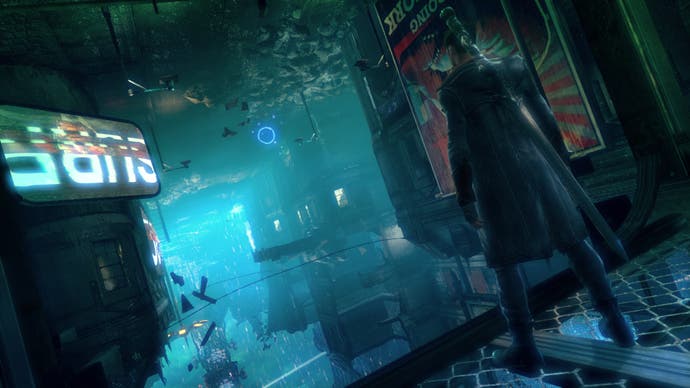
Considering the options available, this is an awesome achievement and crucial to DmC's unbroken flow. Rebellion ties everything together, useful in almost any situation and possessed of a moveset that can branch off in all sorts of directions - small groups can be sliced through quickly while isolated foes can be absolutely dominated by an almost home-run-like combo. Switching mid-battle is the real thrill, though, with each weapon's pace suddenly shifting the tempo of fights. The Angel weapons move you into a hyper-mode of flurries and air-juggling while the Devil weapons slow everything down for an instant of power and precision.
Dante's up against a winningly weird collection of demonic footsoldiers who take inspiration from the original's clockwork mannequins but have a futuristic finish; gleaming fold-out blades, iridescent anatomy and the odd thrilling whirr of a chainsaw. Purists may be divided about how telegraphed the enemy attacks are, with simple wind-ups accompanied by obvious 'glinting', but I still got hit plenty.
One aspect of the mobs that doesn't sit so well is the colour-coding. After a while, blue and red demons will begin appearing, which can only be killed by the same colour of weapon. Hit them with anything else and Dante bounces off, exposed. It's baffling that the game builds such a free-flowing combat system and then at certain points funnels you down it. This proscriptive tendency also shows up in some of the larger 'standard' enemies, who have obvious weak points in their patterns and have to be dealt with in more or less the same manner every time. They can still deal you some serious damage, of course, but fighting them always feels like the same fight.
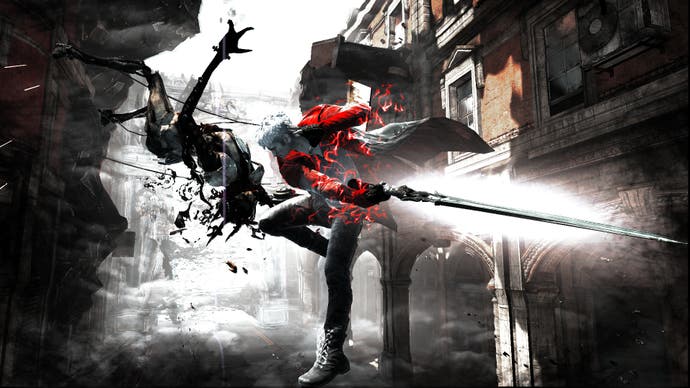
The levels show a visual imagination that few other games can match, channelling everything from Escher to Soylent Green and back via Bayonetta. The settings are often so beautiful and so odd that you spend long stretches between fights just panning the camera. It's not just a still kind of beauty, either; DmC's levels shift and warp as you move through them, often violently twisting into new forms as you progress, and near the game's close there's a fantastic idea involving blueprints. The most spectacular settings are often reserved for DmC's platforming sections - and are all that saves these sequences from total boredom.
A fighting game needs something to change up its rhythm and give players a respite from full-on face-bashing. These platforming sections see Dante chugging along, auto-targeting and swinging from various coloured hooks. It's not that they're terrible, really - they're just not very interesting. No matter how many traversal gimmicks Dante has, he's no Mario, and in contrast to the combat controls he always feels uneasy in the air - liable to overshoot or nixed by a clumsy take-off. The later stages do offer more interesting set-ups, like a sequence where Dante has to help a fleeing car by taking out obstacles in slow-mo, but they all come down to 'hook here, hook there', which is as thrilling as it sounds.
The bigger disappointment is the rogues' gallery of bosses - particularly so given Devil May Cry's past form. Several are great visual ideas - especially the Raptor News host and the foul-mouthed Succubus - but the fights themselves are uniformly disappointing, perhaps because they all feature obvious signposting. Every single boss is beaten through a gimmicky weakness, whether it's yanking a glowy red bit with your chain or pounding a glowy red bit on the ground. There's the odd great moment, but that's the best you can say about them.
For a Devil May Cry game, that's a huge disappointment, but what's worse is DmC's closing act. This is a cataclysm and, sadly, I'm not being literal. A boss rush near the end is a Devil May Cry tradition, but DmC foregoes this in favour of a mundane extended platform stage before a few minor fights tied into a rudimentary puzzle. The final boss fights are an even bigger let-down. The first re-hashes an earlier fight, except it's much easier. The second then squanders a perfect set-up, interrupting its flow five times for unnecessary cut-scene dialogue before yet another gimmick climax. This is no Devil Hand, no Jeanne. DmC's ending should have been a stage for Dante's glorious combat skills in all their free-flowing majesty - but it's a squib.

Fortunately, the game has one last trick up its sleeve. After the credits roll, the 'Son of Sparda' difficulty level is unlocked; this makes the enemies tougher, with extra moves, as well as heavily remixing the encounters in every level. Son of Sparda difficulty does everything it can to overwhelm Dante, with the increased numbers and combinations matched by a rise in aggressiveness. The Nephilim (hard) difficulty I personally found a little on the easy side, but here things start to get properly tough: timing power blows in a crowd, maximising the chains, picking out key targets and smashing them instantly. It's where DmC starts to click and you feel the unmistakeable weight of shackles lifting.
After completing Son of Sparda a further difficulty level is unlocked, the infamous Dante Must Die setting. The leap is much less pronounced than from Nephilim to Son of Sparda, but the increased aggressiveness of mobs mean many more deaths - and the fact they are, once again, remixed gives this so much more replayability than the standard shift between difficulties. Beyond Dante Must Die there's Heaven and Hell mode, which is a fun if throwaway addition - Dante and enemies die in one hit - and beyond even this there's Hell and Hell, where Dante dies with one hit while enemies have full health. I didn't unlock the latter, but clearly only serious mentalists need apply.
The fights the game serves up on these more difficult settings are nothing less than sublime. Sheer numbers force Dante into constant movement and crowd control; get into this new rhythm and he will soon be slicing through the crowd in an unbroken streak, stopping only to buff with perfect evades, throwing in a few parries because he's that damn hot, and finally delivering the coup de grâce with an asteroid punch. Whatever you call that state of intense focus that the best kind of games can bring, once it lets loose, DmC brings it - and then some.
So close. Ninja Theory has succeeded in revitalising a classic series, but DmC is almost a classic in its own right. Don't think too much about the lows, because the highs here are so very high, and show without question that Capcom has faith in the right developer. Ninja Theory has absolutely nailed the leading man and the combat system - by far the most important things - and DmC is clearly a labour of love, a tribute as well as a new beginning.
As for Dante, beneath the attitude and the look and the fancy moves, the most important thing hasn't changed. This guy might be new, but he's still hardcore.


